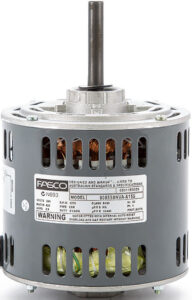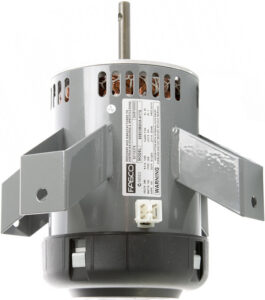Bonaire Evaporative Cooler Fan Motor Testing Procedure
| Make/Model | Date |
|---|---|
| Bonaire Evaporative Cooler Controls (TEK600/PNE Control Systems) | 18/12/2023 |
| Preface: |
|---|
The Bonaire fan motors can develop short circuits, causing excessive current to be drawn and/or the loss of fan speed control.
A fan motor that has developed a short circuit can also damage the control board. While the control board is fitted with a 10A slow-blow fuse, the fan speed control circuitry can only safely handle 16A. In the event of a fan motor short, the slow-blow fuse will not always open fast enough to protect the fan motor control circuitry and the control board will be damaged.
| Isolate Mains Power & Discharge the Room Fan Run Capacitor: |
|---|
Prior to performing any tests, the mains power to the cooler must be turned off and the fan motor run capacitor should be discharged for safety reasons. Under normal circumstances, the fan motor run capacitor can store up to approximately 330V DC and can easily hold this charge for over a week.
Be aware that capacitors can only hold a DC charge, and that DC is more lethal than AC. As capacitors can only hold a DC charge, the multimeter must be set to measure DC volts when measuring the voltage across the capacitor. If the multimeter is set to measure AC volts, it will not measure the voltage correctly and will likely show a low voltage reading when there may in fact be a few hundred volts in the capacitor.
If the cooler is still able to run, the easiest way to discharge the room fan run capacitor to a safe voltage is to start the cooler in “Fresh Air” mode (fan only) and then turn off the mains power to the cooler while the cooler is running. After doing this, set the multimeter to measure DC volts and then measure the voltage across the capacitor to ensure it is at a safe voltage (preferably less than 30V DC).
If the cooler is not able to run (eg. due to blowing fuses or tripping a circuit breaker whenever the fan is started), turn off the mains power to the cooler and measure the voltage across the motor run capacitor.
If the capacitor is holding a high voltage (higher than about 30V DC), it should be discharged for safety reasons. The best way to discharge a capacitor is with a resistive load, not by shorting out the capacitor with a screwdriver or similar, as this not only has the potential to create a decent spark, it may also damage the capacitor.
To discharge the capacitor, a 100 ohm 5W ceramic wire-wound resistor can be used, by connecting it across the terminals of the capacitor for 5-10 seconds. After discharging the capacitor, always check the DC voltage across the capacitor and repeat the discharge procedure if necessary. You can source a suitable resistor from electronics stores, such as Jaycar Electronics or Altronics.
Alternatively, you can try setting the multimeter to measure DC volts and then measure the voltage as above, but keep the multimeter connected to the capacitor until it has discharged. This can take a while, but it will eventually discharge the capacitor. Some multimeters have the ability to measure voltage and provide a small load at the same time, but this feature is usually only found in high end equipment.
| Determine the Fan Motor Wattage: |
|---|
Before checking the fan motor for short circuits in the windings, you should determine the wattage of the fan motor so that you know what readings to expect. Unfortunately, while the fan motor has a sticker on it which will tell you the wattage, it is often covered up by the bracket that holds the fan motor in place.
The wattage of the fan motor can be determined from the model of the cooler using the table below:
| Cooler Model | Fan Motor Wattage | Motor Make/Model | Bonaire Part Number |
| Integra VSS50 | 600W | Fasco 855BPVA-A11 | 6051655SP |
| Integra VSS55 | 600W | Fasco 855BPVA-A11 | 6051655SP |
| Integra VSM60 | 750W | Fasco 855BQVA-A16 | 6051675SP |
| Integra VSM65 | 750W | Fasco 855BQVA-A16 | 6051675SP |
| Integra VSL70 | 950W | Fasco 855-BRVA-B13 | 0160187SP |
| Integra VSL75 | 950W | Fasco 855-BRVA-B13 | 0160187SP |
| Integra VSH85 | 950W | Fasco 855-BRVA-B13 | 0160187SP |
| Summer Breeze SBS55 | 600W | Fasco 855BPVA-A11 | 6051655SP |
| Summer Breeze SBM60 | 750W | Fasco 855BQVA-A16 | 6051675SP |
| Summer Breeze SBM65 | 750W | Fasco 855BQVA-A16 | 6051675SP |
| Summer Breeze SBL70 | 750W | Fasco 855BQVA-A16 | 6051675SP |
| Celair LP/Profile 500 | 600W | Fasco 855BPVA-A11 | 6051655SP |
| Celair LP/Profile 750 | 750W | Fasco 855BQVA-A16 | 6051675SP |
| Celair LP/Profile 850 | 750W | Fasco 855BQVA-A16 | 6051675SP |
Use this table as a guide only. Always confirm your motor wattage and model number by removing the fan motor from the cooler and checking the specifications on the label before ordering a replacement.
| Testing the Fan Motor Winding Resistance: |
|---|
The fan motors have two windings of wire inside them, the START winding and the RUN winding. The windings are wound on top of each other, and cross over each other many times, which increases the chance of a short circuit developing. Short circuits in the motor can happen within a winding or between the two windings, and the test procedure described below will test for all of these potential short circuits.
Also note that just because these tests may pass, it does not mean that the motor is definitely OK. Your multimeter will test resistance using only a few volts DC, while the motor normally runs at 240V AC. If there’s some insulation degradation, it may not be bad enough to show up when the motor resistance is tested with only a few volts. Most times, however, something will show up.
Ensure the mains power is turned off and the motor run capacitor is discharged before proceeding.
To test the fan motor winding resistance, do the following:
-
Disconnect the Brown, Black and Blue fan motor wires from the control board. The earth wire (green/yellow) may remain connected.
-
Measure the START winding resistance by measuring the resistance between the Brown and Black fan motor wires.
-
Measure the RUN winding resistance by measuring the resistance between the Brown and Blue fan motor wires.
-
Measure the SERIES winding resistance by measuring the resistance between the Black and Blue fan motor wires.
-
Once the three measurements have been made, reference the table below to see if they are close to the expected resistance. The resistance of all measurements should be within 5% of the values listed below. If any readings are significantly higher than listed below, re-do the affected test to make sure you didn’t have a bad connection. If the problem persists, double-check the motor wattage, or if the motor is hot, allow it to cool down and do the tests again later.
| Motor Wattage | START Resistance | RUN Resistance | SERIES Resistance |
| 425W | 17.0 | 10.9 | 27.9 |
| 600W | 10.7 | 6.4 | 17.1 |
| 750W | 9.6 | 4.2 | 13.8 |
| 950W | 6.4 | 3.3 | 9.7 |
If the motor winding resistance tests pass, there’s still the possibility that the motor has a short to earth.
The motor should be subjected to an insulation resistance test (this is done with specialised equipment designed for this purpose and is not something that a multimeter is capable of), however you can measure the resistance between the Blue and Green/Yellow wires to check for any shorts to earth. This resistance test should be completely open-circuit and no resistance value should be displayed. If any value is displayed, ensure you are not touching the metal contacts or tips of the multimeter probes while making the measurement. If a short to earth is suspected, also check the grommet/cable strain relief moulding where the power cable exits the fan motor for damage, as the grommet can perish and leave the wires resting on the metal chassis of the fan motor, which will eventually rub through the insulation on the wires due to vibration and cause a short to earth.
| Testing the Control Board Fan Speed Control: |
|---|
If the fan motor has been replaced with a new motor but the fan speed control isn’t behaving as expected, there are two main causes, either a damaged control board or an incorrectly wired fan motor. If not already done, firstly double-check your wiring, paying close attention to the wiring diagram and terminal locations.
Coolers that have PNE control boards have two different motor wiring schemes, depending on the motor used in the cooler. The Integra, CP, LP and Summer Breeze models all use a standard fan motor (see Figure 1). The Envirotech models use the Rocket-Ship mount motor (Figure 2). The motors are wired differently. Refer to the wiring diagram on the back of the control assembly lid or contact us if you need a copy.
 Figure 1: Motor as used in Bonaire Integra, CP, LP and Summer Breeze coolers. |
 Figure 2: Motor as used in the Bonaire Envirotech coolers (Rocket-Ship Mount Motor) |
The fan speed control circuitry usually fails in one of two ways, either fully on or fully off. A fully off failure (no or very little voltage present at the RUN terminal) can result in the fan motor stalling, running slowly or running backwards. A fully on failure of the fan motor control circuitry will result in the fan always running at full speed, regardless of the speed setting.
The voltage at the RUN terminal needs to be measured with a load connected to the terminal, due to other circuitry on the control board. If the voltage at the RUN terminal is measured while nothing is connected to the RUN terminal, you will likely see close to 240V AC, regardless of the fan speed setting. If the fan motor is not faulty, you can leave it connected while doing the measurements. If the fan motor is faulty, it needs to be disconnected entirely from the control board, and another load needs to be connected between the RUN terminal on the control board and one of the neutral terminals on the control board. An example of a suitable load is a 240V incandescent lamp.
-
Set the multimeter to measure AC volts.
-
Put the cooler into “Fresh Air” mode (fan only) and set the fan speed to the lowest possible speed.
-
Measure the voltage between the RUN terminal and neutral. It should measure 100-120V AC.
If the voltage measured was around 100-120V AC, the fan speed control circuitry is probably working correctly. Contact us if you require further troubleshooting assistance.
| Suppliers: |
|---|
Should you need to source a new fan motor, the following companies are reputable suppliers and will sell to both trade and the general public:
VIC: BCB Sales & Service (bcbsales.com.au)
WA: Gamato Manufacturing (gamato.com.au)
| Copyright & Acknowledgements: |
|---|
The photos of the fan motors were provided by Gamato Manufacturing (gamato.com.au) and are used with permission.
